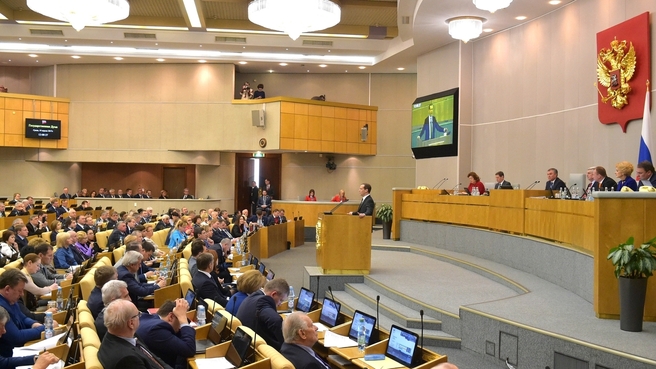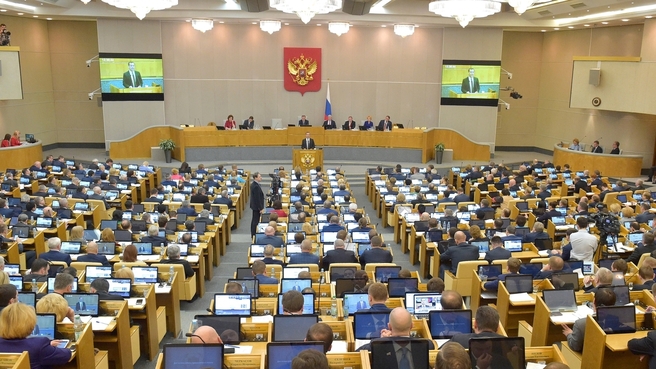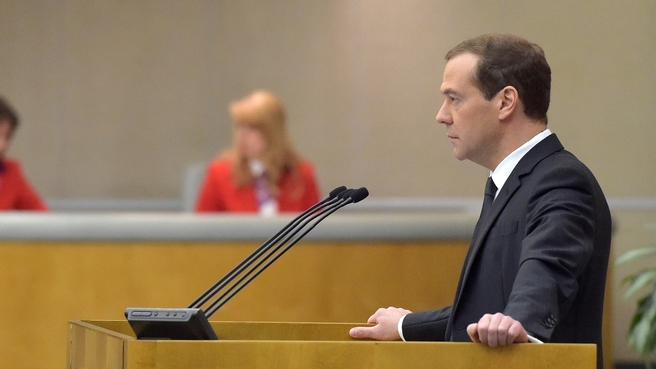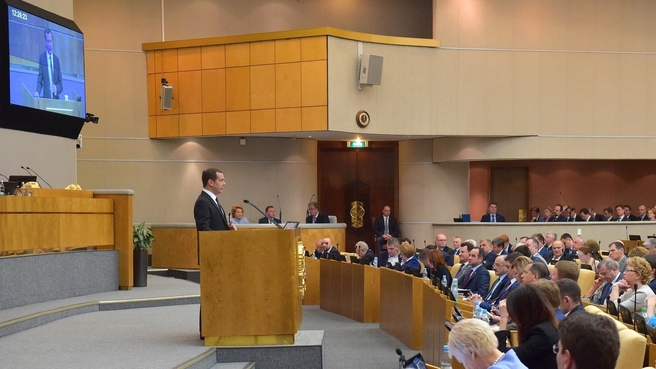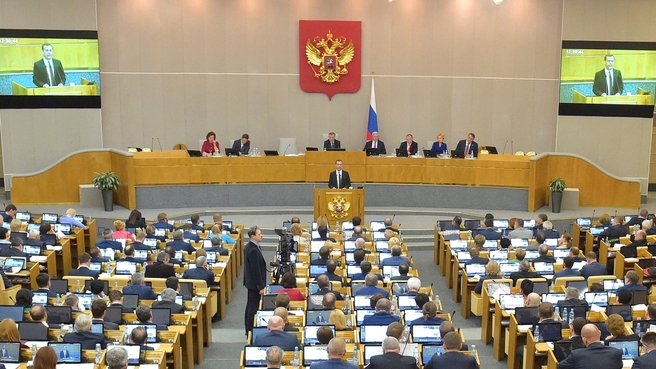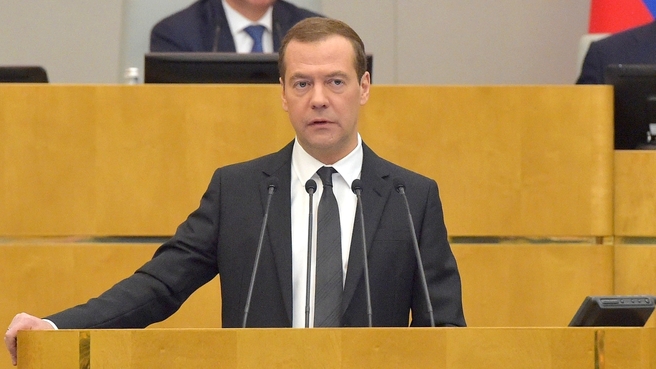“The Government of the Russian Federation <…> shall submit to the State Duma annual reports on the Government’s performance, including on issues formulated by the State Duma.” (Constitution of the Russian Federation, Article 114, Clause 1, Subclause “a”).
Excerpts from the transcript:
Dmitry Medvedev: Last year, the State Duma discussed and adopted 284 Government proposed bills, which have since become law. New members joined the Duma’s legislative process immediately after being elected. As a result, 91 draft laws proposed by the Government were approved last autumn and more than 270 are still being considered. These include important draft laws designed to improve the quality of forensic examination and the effectiveness of cyber protection efforts and to reduce road congestion and improve road safety.
The State Duma election was the main political event last year. Russia’s strategy for the next political cycle was determined on a single voting day. It showed that people see consistency and responsibility for the decisions taken, the ability to listen to people and honour one’s obligations, as well as winning honestly are the most important elements in the government’s work. Our people voted for stability, but they also voted for development. They expect us to do everything in our power to improve their lives and to make success a fact of life in the country. This is society’s main political need today. I am convinced that this requirement will also feature in the upcoming presidential campaign. The race for the presidency will be difficult, as it always is. However, I would like to point out that we never turned a political struggle into a war, and we won’t do it now. Of course, this doesn’t mean that there are no differences. We do have them, which is absolutely normal. But disputes between our political parties, despite the differences in their views and ideologies, only concern the methods for achieving our main goal, which is to continue to develop our country so as to ensure a prosperous life for our people.
On
the political side, we have reviewed our ability to resist external pressure
and have seen that we can also move forward to promote our interests. In the
economy, we saw that we can do more than just respond to crisis situations,
that we can also create new growth
drivers. We have taken a new look at our
opportunities. And we have seen that we can
only rely on ourselves. The sanctions pressure continued, and it will likely
last for some time yet, and oil prices were
low. Nothing has changed in this sense, but we have learned to use the
situation to our advantage as we joined the fight for leadership in domestic
and international markets. We are no longer afraid of any challenges, because
they provide a development impetus. This confidence in our own strength is
bringing its first results. Our economy is
growing, although many people, including those across the ocean, predicted an
economic catastrophe for us. Today, our progress has been acknowledged even by
those who cannot be suspected of being partial to Russia.
Dmitry Medvedev: “Last year, the State Duma discussed and adopted 284 Government proposed bills, which have since become law. Last autumn, 91 draft laws proposed by the Government were approved and more than 270 are still being considered at various levels. These include important draft laws designed to improve the quality of forensic examination and the effectiveness of cyber protection efforts and to reduce road congestion and improve road safety.”
Over the last six months, two major rating agencies of the Big Three, I mean Fitch and Moody’s, have changed their Russian economy forecasts from “negative” to “stable.” Yet another agency, S&P, has upgraded its forecast to “positive.” By the end of this year, Russia may return to the category of countries with an investment rating. This signifies additional opportunities for an inflow of funds and for solving other problems.
Last year, our country climbed to the 43rd position in the world competitiveness rating. Our positions have grown for four years in a row, and this happens amid a financial crisis. We consistently advance in the World Bank’s Doing Business ranking of economies, which estimates the quality of a business climate. There are also significant changes here: we have climbed 80 places over the last five years. Ours was the 120th position in the world among 200 UN member states; today we are in the 40th slot. We have been ahead of our BRICS partners for two years now.
The economy is growing more effective and businesses are finding it easier to operate. There are ratings-related successes in such areas as healthcare and education. There is progress, albeit insignificant, in every area of critical importance for national development. This means that we have here not just individual successes but system-wide improvements. By and large, our country is moving ahead.
An increase in life expectancy is perhaps the main result. Since 2006, life expectancy has grown by 6 years to almost 72 years. This is the highest indicator in our country’s entire history. More than 10 years ago, we addressed the demographic problem in earnest. Today, Russia has a population of 146.8 million. We are ahead of many European countries in terms of birthrate. Among other things, this is a result of measures we take, primarily the maternity allowance, monthly allowances for a third child, allocation of free plots of land, kindergarten problem solutions, and helping working mothers.
There is yet another important achievement: the number of orphans decreased from 120,000 in 2012 to less than 60,000 in 2016. This work must be continued.
Secondly, healthcare. Last year, according to the WHO, Russia made it to the top ten countries with the most progress in fighting heart and lung diseases and diabetes, over the past years. Most importantly, the mortality rate caused by these conditions is decreasing.
Childbirth and infant mortality rates are also going down. They decreased by almost 75 percent in 25 years, or the entire history of modern Russia. Since 2011, the infant mortality rate has dropped by almost half, and by 7.7 percent in 2016 compared to 2015. This is mainly due to new perinatal centres.
We have built advanced medical care centres across the country. The number of patients who have received this form of healthcare has grown by an unprecedented figure, three times since 2010. Last year alone, assistance was provided to 960,000 people. When we only started this nationwide project it was available to only 70,000 patients.
Dmitry Medvedev: “Our main goal is to continue to develop the country so as to ensure a prosperous life for our people. In this regard, last year was a very important one. It was not an easy year, with strict resource-saving policies in place; but it was a year that made us aware of our opportunities.”
We are working on new centres in regions where nuclear medicine, regenerative medicine and modern personalised health technology will be used.
This year, some 34 regions are launching a priority project to develop airlift services. We have allocated 3.3 billion roubles for this. Also, the federal budget sponsored an ambulance fleet upgrade, with 2,300 new vehicles purchased last year.
For a long time, rural areas have been affected by a shortage of doctors. Thanks to the Rural Doctor programme started by United Russia, almost 24,000 doctors have moved to villages to work since 2012. We decided to extend this programme another year and increase federal funding by about 60 percent.
We are trying to restrain any unreasonable increase in medication costs. We support domestic makers. This will continue. It requires new measures. As a pilot programme, six regions are implementing a labelling system to protect consumers from counterfeit drugs. By the end of 2018, all Russia-produced medications must be properly marked.
Even today, one in every four Russian citizens is a pensioner. Last year, we approved an action strategy to support senior citizens. This year, we allocated funds to improve the accessibility and quality of social services for seniors.
Dmitry Medvedev: “An increase in life expectancy is the main result. Since 2006, life expectancy has grown by 6 years to almost 72 years. This is the highest indicator in our country’s entire history.”
We continue to develop the pension system. In 2012, we adopted the Strategy for the Long-Term Development of the Pension System Until 2030. This brought new money into the Pension Fund almost immediately, reduced its budget deficit, and improved the collection of pension contributions.
We continue to improve the insurance mechanism too. We have transferred administration of pension contributions to the tax system. Of course, we encounter difficulties on the way. Last year, we were unable to index pensions in full. We were well aware that elderly people do not have it easy, but we did not promise what we could not deliver at that moment. When it became possible, pensioners received a one-off payment on top of their pensions. Of course, we know that this is not enough. This year, pensions will be indexed in accordance with the law. Furthermore, as of February 1, we went over to a system of indexing all federal social transfers to account for actual inflation. This is the first time we have done this.
The economic situation over these last few years has had a negative impact on these payments, of course. Wages are not high in the country today, but we are taking measures to correct this situation and are looking for additional resources to help those with low incomes.
This concerns, above all, wages for people working in the field of education, healthcare and culture, in accordance with the goals set in the 2012 presidential executive orders.
Last year, we doubled the minimum wage to 7,500 roubles. From July 1 this year, the minimum wage will be increased to 7,800 roubles, and over the next few years the minimum wage will be increased to reach the minimum subsistence level for the working population. We have everything so that we can achieve this.
The Russian Government will also continue supporting the labour market. Unemployment is not as much of an issue today as it was two years ago or in 2009. Last year, there were fewer unemployed registered with employment services than the number of available jobs. The unemployment rate stood at 5.5 percent, and this year we expect it to drop below 5 percent, which is a normal unemployment rate close to the global average.
Only recently, western foundations did not hesitate to recruit employees directly from Russian universities. They simply came and poached the most capable ones. This was a real hunt for talent. Today, we are doing our utmost to overcome this brain drain. Total research spending has increased in recent years. It is also important that this segment is beginning to benefit from private investment as well.
We have increased grants for young PhD and DSc holders. A programme was launched called Mega-Grants, whereby 160 world-class laboratories were created at Russian universities and research institutions, headed by world-renowned researchers from Russia or abroad. Another 40 laboratories of this kind will be created in 2017. These institutions offer new growth opportunities for Russian science. They also include engineering centres and innovation youth centres.
We must foster competition among major Russian corporations for the right to participate in educational projects, which goes for both higher education and vocational training. The education system should be linked to the economy and tailored to meet the needs of employers. Science and technology R&D projects funded from the budget should be focused on the needs of Russia’s industrial sector.
Dmitry Medvedev: “We have increased grants for young PhD and DSc holders. A programme was launched called Mega-Grants, whereby 160 world-class laboratories were created at Russian universities and research institutions, headed by world-renowned researchers. Another 40 laboratories of this kind will be created in 2017. These institutions offer new growth opportunities for Russian science. They also include engineering centres and innovation youth centres.”
By 2025, schools will be able to accommodate 6.5 million more schoolchildren. The first schools have already been built as part of the effort to meet this target, accommodating 168,000 schoolchildren in 48 regions. We are also working on a project to create a national e-learning platform that would ensure that libraries, museums and exhibitions can be accessed online. In small cities, state-of-the-art integrated cultural centres are being created, theatres and museums renovated. Spending on culture currently stands at almost 100 billion roubles.
Already in the fourth quarter of 2016, the economy showed a small increase of 0.3 percent. As of late 2016, we had a major slowdown in the decline of GDP compared to a fall of almost 3 percent in 2015. Such figures have become possible not because of improvements in the global economic situation which remains difficult for our country, both subjectively and objectively, but as a result of our joint work.
Dmitry Medvedev: “Our schools need an up-to-date learning environment. By 2025, schools will be able to accommodate 6.5 million more schoolchildren. The first schools have already been built, accommodating 168,000 schoolchildren in 48 regions. These are new school buildings, new classrooms and labs – all that surrounds the children and helps them learn using advanced educational technologies.”
Inflation stands at 4.2 percent year on year. Two years ago, it was measured in double digits. The Central Bank is gradually lowering the key rate, which means that consumer and commercial loans are becoming more affordable. Mortgage rates are at a record low for our country. Hence, there are additional opportunities for investments. Our companies and banks have no problem servicing their external debts. There is no deficit on the foreign exchange market, no demand frenzy.
A short while ago, more than two thirds of our budget − taking into account the reserve fund spending − depended on oil and gas exports. The situation has changed, and budget revenues from other industries amount to more than half of our budget. Even though the price of oil and gas edged up last year, non-oil-and-gas proceeds accounted for almost 60 percent of the total federal budget revenue in the first quarter of this year. We manage to keep the budget deficit at an acceptable level. The reserve fund is the main source for covering the deficit. In theory, we were supposed to have run out of the money in this fund by the end of this year. However, this will not happen. We earned more than we planned, including through revenue mobilisation. We still have enough reserves. We are fine-tuning the budget payment system to improve its efficiency.
We formulated 10 priority areas: healthcare, education, mortgages and rental housing, housing and communal services and urban environment, international cooperation and exports, small-sized businesses and support for entrepreneurial initiatives, reform of control and supervisory activities, safe and good quality roads, monocities and ecology . The project approach is an excellent opportunity to introduce state-of-the-art management technologies at state level.
Dmitry Medvedev: “Inflation stands at 4.2 percent year on year. Two years ago, it was measured in double digits. The Central Bank is gradually lowering the key rate, which means that consumer and commercial loans are becoming more affordable. Mortgage rates are at a record low for our country.”
When forming the budget, one must proceed from three fundamental principles: firstly, money, should go to investing in a person; secondly, the implementation of infrastructure projects; thirdly, to ensure national security.
A few years ago, a decision was made on the stability of the tax system, and therefore we do not plan to raise taxes this year.
In fact, the freeze on tax increases has been in place for over three years. Most of the changes were adopted based on 2016 tax revenue, which was spent on improving tax collection and to attract additional revenue by expanding the tax base.
Tax returns in the first quarter of this year went up by almost one-third year-on-year. We managed to improve tax collection rates and this is a positive outcome. The simplified VAT refund procedure for major tax payers was updated. Some tax incentives were provided to small businesses. Specifically, we decided leave in place the unified tax on imputed income, the easiest and most popular tax schedule.
We continue to introduce tax relief measures for business. We transferred the administration of social contributions to the tax services. The Government introduced a three-year freeze on scheduled inspections of small businesses. Certain laws on business supervision and related criminal legislation were relaxed. For corporations with an annual revenue of at least 400 million roubles, there is immunity against certain anti-monopoly bans. Accounting requirements were simplified.
The total lending limit for small and medium-sized businesses almost doubled to 125 billion roubles last year.
These measures have produced the first effect. The number of small and medium-sized companies is growing. From August 2016 to March 2017, their number increased by 8.2 percent. In other words, the number of our small-sized businesses is not decreasing but growing overall, and their contribution to GDP is also increasing. It is now about 20 percent.
Dmitry Medvedev: “A short while ago, more than two thirds of our budget − taking into account the reserve fund spending − depended on oil and gas exports. The situation has changed, and budget revenues from other industries amount to more than half of our budget. Non-oil-and-gas proceeds accounted for almost 60 percent of the total federal budget revenue in the first quarter of this year. We manage to keep the budget deficit at an acceptable level. We earned more than we planned, including through revenue mobilisation.”
More and more interest in Russia is being shown by foreign investors. The Russian economy’s major advantages – and it does have its advantages – are its high profitability, rich resources and skilled labour. We can add to these low inflation rate and several other advantages we can offer as members of the Eurasian Economic Union. As a result, investments in the economy stabilised by the end of 2016. They will start growing this year.
We did not wait for the crisis to destroy our real economy companies and whole cities. As well as this, we didn’t listen to various experts and analysts who told us that the crisis would sweep everything away and that it was a positive thing which we must simply endure. However, we didn’t accept this. Instead of dismissing workers, we used a targeted support system to help the most vulnerable companies. We used government assistance tools to stimulate productivity, to introduce new technologies and increase competitiveness. And eventually we reached success in import substitution.
Import substitution was an informed decision. It is not a goal by itself, a process for the sake of process, or an opportunity to preserve at any cost uncompetitive companies.
Products made in Russia should meet the highest consumer expectations on the domestic and global markets.
This is not about penetrating the existing global trade system and turning it upside down. We must form alliances when it would seem advisable to do so. What matters the most is that we develop technological know-how in Russia instead of simply assembling imported car kits.
Specifically, special investment contracts were introduced to this effect whereby investors are guaranteed fixed terms in exchange for the commitment to invest in increasing the share of localised manufacturing in a given enterprise.
The Industrial Development Fund offers loans at a 5-percent interest rate, and its programmes are quite popular.
We provided additional support to specific sectors, including car manufacturing, textiles, agricultural machine building and vehicle engineering, for a total of 106 billion roubles last year. This year, we allocated a similar amount of 108 billion roubles to this effect.
All this adds up to a balanced system of measures which made the real sector stronger and ready to grow.
Industrial output grew by 1.3 percent in 2016, and we expect to see 2-percent growth in 2017.
A number of sectors showed even higher growth rates. Specifically, I am talking about the pharmaceutical and medical industries. Domestic production of medicine surged almost 25 percent. In terms of essential medication, the self-sufficiency rate, i.e. the share of medicine produced domestically, reached 77 percent.
Concrete steps were developed to improve all cities across Russia, including the creation of parks, pedestrian areas, playgrounds, sports courts and cultural spaces. The Government instructed municipal entities to draft and carry out five-year comprehensive renovation programmes.
The Government is about to deliver on the task set by the President to relocate people from residential buildings that were recognised as being dilapidated and substandard as of 1 January 2012. This year, 200,000 people living in 3 million square metres of housing will be relocated as part of this effort.
More than 860,000 living in 13 million square metres of substandard housing have been relocated under this programme since 2008.
Last year, 176,000 people moved to new apartments. Overall, the target set for 2016 under this programme was exceeded by 5 percent.
In 14 regions, run-down residential buildings of this kind have already been demolished.
Some 80 million square metres of housing was built in 2016. Tens of thousands of people moved to new flats. Housing construction is largely growing thanks to a developed mortgage market. In 2016, the issuance of mortgages increased by 25 percent compared to 2015. This is largely thanks to the government programme of subsidising mortgages for the purchase of new housing.
Agriculture: It has been growing for the past few years, by an average of up to 4 percent a year and by nearly 5 percent in 2016. Last year we saw record achievements in agriculture. In 2016 we saw the largest grain harvest in 25 years. Fruit, vegetable and meat production continues to grow.
We allocate considerable funds to subsidise short-term loans. We have supported new investment projects, issued grants to small and medium businesses and created a new system of favourable lending facilities with an interest rate of up to 5 percent. We see demand for Russian-made agricultural equipment on the domestic and foreign markets. Our exports increased by over 5 percent last year.
Agricultural machine-building: It grew 150 percent last year, including thanks to the government system of discounts. The proportion of Russian-made equipment on the market has grown to over 50 percent. Only recently, only foreign harvesters and tractors were available for our agricultural producers, whereas now over half of this equipment is made in Russia. The share of imported machinery is very low, only 6 percent of the total. This goal can be also achieved in other industries.
Car manufacturing: We have achieved good results in some sectors despite general problems in the industry. For example, we have increased bus manufacturing by more than one third.
The infrastructure sectors have reported good results. The fuel and energy sector demonstrated confident growth and even records. These include, first, the production and export of oil from the deposits for which special terms were approved, second, coal production, and third, the export of natural gas. We continue to increase gas deliveries, Turkish Stream gas pipeline included. And fourth, very good results were reported for electricity production at nuclear power plants.
Last year we built or renovated 3,300 kilometres of roads, built seven and renovated 30 bridges, and the number of congested roads decreased by 25 percent.
Domestic flights: We are subsidising their development. As a result, 56.5 million people bought air tickets last year, which is 7 percent more than in 2015.
Last year, our railway companies transported over 1 billion passengers and 1.2 billion tonnes of cargo.
By decision of the Government, a 50 percent discount for railway tickets was in effect for school students around the year. In all, 2.3 million students took advantage.
Our defence companies were the first to be hit by the sanctions and pressure. This is why they were also the first to launch the import substitution programme. The country’s defence capability depended on this. As a result, our defence sector increased production by over 10 percent.
Labour productivity is up 13 percent for the year. State defence procurement was fulfilled at a record 99 percent in 2016, which is unprecedented. In terms of nuclear weapons, the number is 100 percent.
We rank second on the global armaments market. Our military exports exceeded $15 billion. New contracts have been signed, and the order books totaled $50 bn as of late 2016.
With regard to the aviation industry, 30 civil and 109 military aircraft, and 22 civil and 186 military helicopters were built in 2016. Our civilian aviation equipment is still behind the Air Force in terms of numbers, but we will work to level out this ratio.
The first civilian cosmodrome, Vostochny, opened in 2016. The Soyuz rocket was launched from there. Two more launches are scheduled for this year. The second launching pad for the Angara heavy-duty rocket is being built.
Six warships were commissioned in 2016, two submarines and [four] surface ships. Completed civil orders include the Polaris icebreaker which runs both on diesel and liquefied natural gas, and the icebreaker Novorossiysk, which is the third in a series of the most powerful diesel-electric icebreakers. The development of an atomic lead icebreaker with a capacity of 120 MW is underway. The world's most powerful all-purpose next-generation atomic icebreaker Arktika and non-nuclear Alexander Sannikov and Viktor Chernomyrdin icebreakers were launched as well.
Overall, we can talk about the revival of our nuclear icebreaker fleet, the only one in the world. This is important for the viability of the Northern Sea Route and for developing the Arctic.
Consistent development of the country’s territories is a serious task for any large country. Russia is no exception, so we proceed based on two principles: first, we help the regions identify proper development guidelines and coordinate their investment plans, and, second, we increase the responsibility of the regional authorities and have them focus on concrete results.
We are adjusting state programmes and investment programmes for public companies as we link them with promising projects. Businesses and the state must work together.
We continue to develop the project financing mechanism.
Improving the investment climate is the number one issue for the regional authorities as well.
We have preserved our financial support system for the regions. It has become more motivation oriented. The regions have obligations that they take on when receiving assistance.
The Government continues to help the regions. The subsidies to level out the budget sufficiency have been increased by 100 billion roubles and the same amount has been provided for subsidies to co-finance expenditure commitments.
A special programme has been launched for single-industry towns. Seventeen priority development areas have been established. Thousands of jobs were created last year outside backbone employers.
In 2016, the population loss in the Russian Far East decreased by 33 percent. This macro-region has reported industrial production growth for the past few years. The number of priority development areas there has increased to 15. New construction projects have been launched, and a system of infrastructure support for large investment projects has been introduced.
The Far Eastern hectare programme was presented less than one year ago. However, 11,000 hectares already have owners. We have received 82,000 applications. This means that people are interested in and are willing to move to the Far East. Our other decisions have proved effective, including on the Vladivostok free port, subsidising air flights and developing transportation corridors.
We faced no less challenging tasks in the Crimea. The past year and the year before that were a transition period. The Crimea was dealing with the consequences of the [Ukrainian] blockade and integrating into the Russian legal and economic space. This work is not over yet, but the situation has changed dramatically. This includes the dependence of the Crimean and Simferopol budgets on the federal one. The connection of the Crimean energy system to the national energy system of Russia was a signal event. The last part of the energy bridge was launched last year, and a trunk gas pipeline opened in December. This is a big step towards Crimea’s energy security.
We continue to build the Kerch Bridge and modernise federal routes running to it from the Krasnodar Territory. In the meantime, the connection is provided by a ferry line. It keeps increasing its operation. It has increased passenger transportation by one third to 6 million people. The number of tourists travelling to the Crimea has also increased, to 5.5 million in 2016, or twice as many as in 2014.
The figures I have cited show that we have chosen the correct path. These figures are the result of our daily work, and the economic and external challenges will not stop us from working towards our goals.
